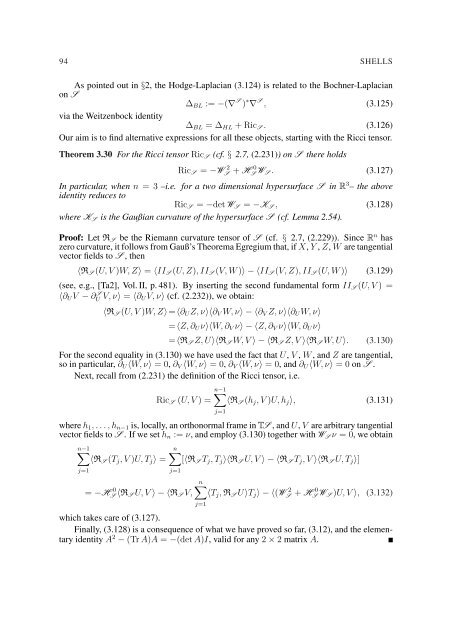EQUATIONS OF ELASTIC HYPERSURFACES
EQUATIONS OF ELASTIC HYPERSURFACES
EQUATIONS OF ELASTIC HYPERSURFACES
Create successful ePaper yourself
Turn your PDF publications into a flip-book with our unique Google optimized e-Paper software.
94 SHELLS<br />
As pointed out in §2, the Hodge-Laplacian (3.124) is related to the Bochner-Laplacian<br />
on S<br />
∆ BL := −(∇ S ) ∗ ∇ S , (3.125)<br />
via the Weitzenbock identity<br />
∆ BL = ∆ HL + Ric S . (3.126)<br />
Our aim is to find alternative expressions for all these objects, starting with the Ricci tensor.<br />
Theorem 3.30 For the Ricci tensor Ric S (cf. § 2.7, (2.231)) on S there holds<br />
Ric S = −W 2 S + H 0<br />
S W S . (3.127)<br />
In particular, when n = 3 –i.e. for a two dimensional hypersurface S in R 3 – the above<br />
identity reduces to<br />
Ric S = −det W S = −K S , (3.128)<br />
where K S is the Gaußian curvature of the hypersurface S (cf. Lemma 2.54).<br />
Proof: Let R S be the Riemann curvature tensor of S (cf. § 2.7, (2.229)). Since R n has<br />
zero curvature, it follows from Gauß’s Theorema Egregium that, if X, Y , Z, W are tangential<br />
vector fields to S , then<br />
〈R S (U, V )W, Z〉 = 〈II S (U, Z), II S (V, W )〉 − 〈II S (V, Z), II S (U, W )〉 (3.129)<br />
(see, e.g., [Ta2], Vol. II, p. 481). By inserting the second fundamental form II S (U, V ) =<br />
〈∂ U V − ∂ S U V, ν〉 = 〈∂ UV, ν〉 (cf. (2.232)), we obtain:<br />
〈R S (U, V )W, Z〉=〈∂ U Z, ν〉〈∂ V W, ν〉 − 〈∂ V Z, ν〉〈∂ U W, ν〉<br />
=〈Z, ∂ U ν〉〈W, ∂ V ν〉 − 〈Z, ∂ V ν〉〈W, ∂ U ν〉<br />
=〈R S Z, U〉〈R S W, V 〉 − 〈R S Z, V 〉〈R S W, U〉. (3.130)<br />
For the second equality in (3.130) we have used the fact that U, V , W , and Z are tangential,<br />
so in particular, ∂ U 〈W, ν〉 = 0, ∂ V 〈W, ν〉 = 0, ∂ V 〈W, ν〉 = 0, and ∂ U 〈W, ν〉 = 0 on S .<br />
Next, recall from (2.231) the definition of the Ricci tensor, i.e.<br />
∑n−1<br />
Ric S (U, V ) = 〈R S (h j , V )U, h j 〉, (3.131)<br />
j=1<br />
where h 1 , . . . , h n−1 is, locally, an orthonormal frame in TS , and U, V are arbitrary tangential<br />
vector fields to S . If we set h n := ν, and employ (3.130) together with W S ν = 0, we obtain<br />
∑n−1<br />
〈R S (T j , V )U, T j 〉 =<br />
j=1<br />
n∑<br />
[〈R S T j , T j 〉〈R S U, V 〉 − 〈R S T j , V 〉〈R S U, T j 〉]<br />
j=1<br />
= −H 0<br />
S 〈R S U, V 〉 − 〈R S V,<br />
n∑<br />
j=1<br />
〈T j , R S U〉T j 〉 − 〈(W 2 S + H 0<br />
S W S )U, V 〉, (3.132)<br />
which takes care of (3.127).<br />
Finally, (3.128) is a consequence of what we have proved so far, (3.12), and the elementary<br />
identity A 2 − (Tr A)A = −(det A)I, valid for any 2 × 2 matrix A.

















